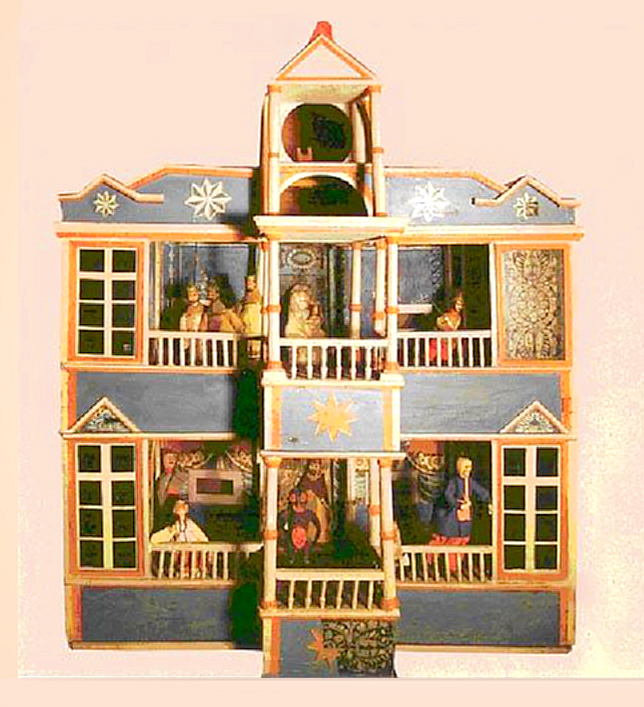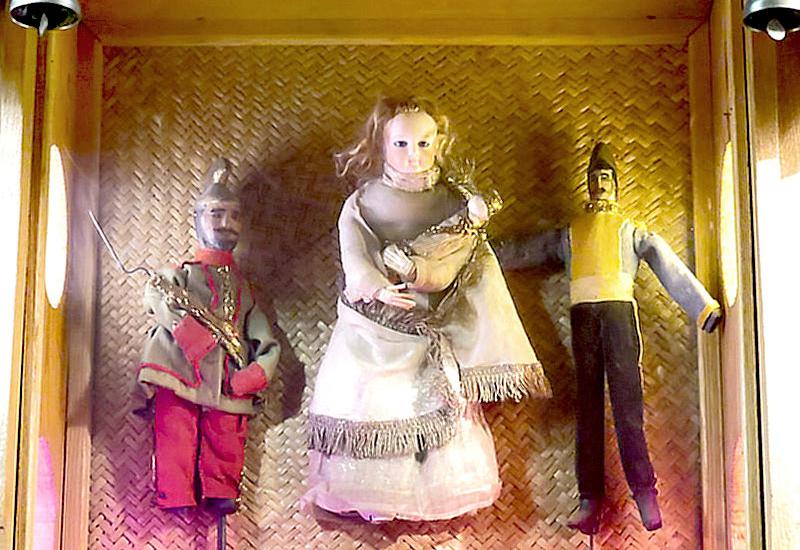Christians celebrate twelve days from Christmas to Epiphany – from star to water. For centuries, caroling and nativity scenes (costumed street performances) have been their most important theatrics. Once upon a time, these performances were puppet shows, with characters and scripts sanctified by age-old traditions. Let us talk about them.
What is a nativity scene?
One can only wonder how quickly the perception of some words is changing in today's world. For example, in just three decades, the perception and understanding of the word “nativity scene” have almost completely changed in the minds of Ukrainians. In Soviet times, and even at the end of the last century, for the vast majority of us, it meant only something very ugly - a hut, a place to hide and hide criminals or prostitutes, etc. Today we primarily mean a merry Christmas action with carols, jokes, and short theatrical plays. Or just a model of a cave or a stable in Bethlehem on the night of the Nativity of Jesus Christ, which is also called “shopka” in the Polish.
However, even in Soviet dictionaries, the negative meaning of “nativity scene” was not in the first place. On the contrary, classic Borys Hrinchenko's Dictionary of the Ukrainian Language, published in 1907, did not have such a meaning at all! Moreover, the word “nativity scene” was associated not with a generally merry Christmas action, but with a theatrical performance. The dictionary told about a traveling puppet theater that played Christmas mysteries.
The fact that the Christmas mysteries were performed in the nativity scene directly indicates the etymology of this word. However, all dictionaries recorded the meanings - both old and modern. Its initial sense is a cave (from the Slavic “врътъпъ”) because it was in the cave that the stable where Jesus was born was. So they showed nativity scenes on holidays.

How a traditional Ukrainian vertep was arranged
Usually, nativity scene (vertep) performances were dedicated to one of the greatest Christian holidays of the year. The puppet show not only retold New Testament stories but also described the living of the people. Therefore, the performance was divided into two separate sections – “sacred” (“heaven”) and “secular” (“earth” or “palace”).
Moreover, a typical vertep was a one or two-story wooden box used as a scene for a puppet show. The box was a real doll's house made of boards and cardboard. The floors had slots, behind which puppet stories were played out. The upper floor of the two-storied box was used for the nativity scene, the lower one was for comic-domestic interludes and other mystery plays, which were sometimes associated with ordinary and festive events. Some researchers believe that wooden boxes were three-story. “Sky” and “earth” were divided and included the technical floor between. The 3rd floor served for storing “actors” and all sorts of devices for theater act.
The puppeteer played a scene by moving rods of puppet characters attached to them through the slits on the scene floor. It was possible to move the rods with the heroes of the performances along with the box so the dolls could also turn in all directions. By the way, according to ethnographer Mykola Markevych, the floor was covered with fur so that the slits could not be seen. There was a door on the right and left parts of the scene. The puppet came on the scene from one door and left the scene in another.
The show was not only amusing but also quite charming. The “sky” was sometimes decorated with blue paper or cloth. The back wall of the scene depicted Christmas scenes from the Scriptures. The “palace” was also decorated with colored paper, fabric, or foil. The puppets were wearing colorful robes. The top floor clothes corresponded to biblical stories outfit (although, in fact, they reflected the idea of such wearing). The characters on the first floor copied the clothes from the festive costumes of that time.
Creators of Vertep Drama
There was a whole genre of Vertep Drama that had its own canons and the division into negative and positive characters. At the same time, the Vertep Theater had clearly defined characters, which reached 40. The characters of the second-floor performances - Kings-Magi, Herod, Warrior, Rachel, Death, and Devil - have unchanged for centuries. The protagonists’ changes, on the contrary, depended not only on time but also on the place where the natives gave a performance. They included characters like the Man, Shepherd, Grandmother with Grandfather, Young Man and Girl, Palamar, Pan, Merchant, General, Officer, Muscovite Soldier, Innkeeper, Pole, Gypsy, again Devil and others. The main character was Zaporozhian Cossack (in folk plays recorded in the 20th century - also Haidamak Cossack) He always defeated the evil force and all sorts of oppressors of the ordinary people to the laughter and applause of the audience.
The characters of the upper part of the play gave an idea of what it was about. For instance, a dramatic retelling of the Gospel story of the birth of Jesus. King Herod, fearing a future rival on the throne of the King of Judah in Bethlehem, got rid of all male infants 2 years of age and younger. According to the researchers, the first act of the play remains almost the same, except for some linguistic differences and simplifications as well as abbreviations in later versions. So everything proves that the origin of this sacred part of vertep was taken from books. Scholars believe that it was introduced by unknown authors from the Kyiv Academy. If it was not they who created the canonical text of this part of the nativity drama, they gave it a literary design. The fact that one of the most complete versions of vertep (the so-called “Galagan” or “Sokyrnian” list) was written in 1770 by the Kyivan bursaks confirms the origin of the Vertep Drama.
As for the second act, which took place “on earth”, it originated from folk art. That is why we can find significant differences in the descriptions of the real-life realities in the vertep texts of the 18th and 19th centuries. Besides, the protagonists' clothes, as described, differed even when they were the same characters. This part of vertep did not have a core dramatic plot but was a series of comic scenes and interludes with different characters easily recognizable for the audience and met with laughter.
Ukrainian vertep: four-century history
Researchers believe that the Vertep Theater appeared in Ukraine at the end of the 16th century. Polish ethnographer and folklorist Erasmus Izopolsky proved it with the inscription in Church Slavonic font: “The year of Christ 1591 was built” was written on the vertep box in the village of Stavyshche. The nativity scene was brought to Ukraine from Western Europe, where a puppet theater with religious mysteries was very popular since the Middle Ages. Vertep fascinated Poland or, as Ivan Franko believed, came through Germany, and amused students and teachers of the Kyiv Academy. The ordinary people quickly fell in love with this theatrical performance. Over time in Ukraine, the Vertep Theater underwent significant transformations. Performances for ordinary peoples were a satirical, sometimes quite sharp reflection of everyday and significant historical events that concerned the audience. That is the reason why vertep managed to live to the first half of the 20th century. However, cultural historians say that nativity scene began to decay in the middle of the 19 century.
Nevertheless, the last known authentic nativity scenes were recorded in 1927 (Zhytomyr), in 1928 (Slavutyn and Khorol) and even in 1940 (Kupiansk). It is clear that they also contained reflections of recent revolutionary and military disasters and new characters, for example, Haydamak Cossack. He resembled a soldier of the Ukrainian army in all aspects.
As the Soviet government terminated “religious remnants”, it could not allow such performances because they contained biblical narratives and outright allusions to the surrounding reality. So it was then that vertep as a separate genre of folk theater ended.
However, at least one attempt is known to make Ukrainian vertep serve to the new regime. The initiators were students and teachers of the Mezhyhirya ceramic college. Using techniques of the traditional vertep, they tried to make their revolutionary performances an instrument of satire. They wanted to promote communist ideas, fought the internal and external enemies of the “workers and peasants state” and, of course, religion. However, a folk puppet theater with a distinctly national character ended after the Mezhyhirya Vertep toured in 1924 in Kharkiv. It could not satisfy the then leaders of proletarian culture.
Still, there were attempts to return the traditional folk nativity scene to the Ukrainian cultural space. A new Ukrainian vertep was enriched with new ideas and means of professional theatrical art. In 1974-1975, the Kharkiv Puppet Theater prepared and staged the play “Ukrainian Vertep”. The author of the box and puppets was artist Oleksii Shchehlov. The author of the text and director was Oleksandr Iniutochkin). Another attempt made the Kyiv City Puppet Theater (now - the Kyiv Academic Puppet Theater on the left bank of the Dnieper) in 1992. The artist was Iryna Uvarova, the director - People's Artist of Ukraine Serhii Yefremov. Modern vertep performances were a great success and got numerous prizes. Since the 1970s, Bohdan and Taras Zheplynski, Volodymyr Shagala are passionate defenders and custodians of folk songs, traditions, customs. They have performed at nativity festivals in the Lviv region. However, that is another story…

